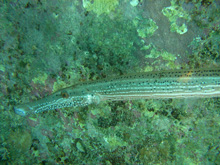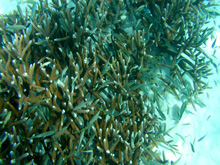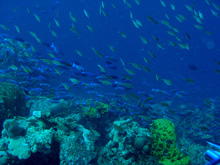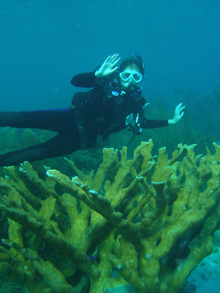Scouting Out the Island and the Reefs of Bonaire
A stealthy predator, the trumpetfish likes to imitate sea whips and hide next to other fishes like parrotfish and jacks. Click image for larger view and image credit.
The staghorn coral grows quickly. This stands has grown back since Hurricane Lenny in 1999. Note how many small fishes live among the branches. Click image for larger view and image credit.
January 7, 2008
Mark Patterson
Expedition Leader
Associate Professor of Marine Science
Director, Autonomous Systems Laboratory
Virginia Institute of Marine Science, College of William & Mary
After a red-eye flight from Houston on December 30, Mark and Susan Patterson arrive at Flamingo International Airport with two of Mark’s long-time field associates dating back to his graduate-student days, Drs. Doug Mason and Lisa Chang. All of us have our kids in tow for the first few days, all of them "aquakids" and the next generation of marine scientists. They prove invaluable at spotting anomalies on the reefs during the next few days of scouting. They also help us meet the locals and off-islanders, all of whom are incredibly friendly.
Dale Stokes, our physical oceanographer from Scripps, arrived a few days before us. He has grown up on the island during summers and holidays, and knows Bonaire underwater like the back of his hand. However, it seems not all is in order for our shipment to be released. It is a mountain of gear, including three free-swimming robots (autonomous underwater vehicles), dive gear, and sophisticated bottom-mounted instruments. Bringing this value of science goods into the island territory does not happen every day. Part of the complication is that the shipments have come from Delaware, Iceland, and Canada. We have quite the international team arriving shortly after the New Year.
Later in the day, Art Trembanis and his graduate student Hilary Stevens arrive. Art and Hilary are from the University of Delaware and will be studying the reef using one of the underwater robots. They are experts in sediment transport and geology. Art, along with Doug Miller (another professor and marine ecologist from Delaware), is also helping teach a study-abroad course involving 16 undergraduates. They arrive later in the week and will be taking over an entire hotel.
Many fish species make a living eating tiny zooplankton (drifting animals) that pass over the reef. They are mesmerizing to watch. Some studies show that these fishes can have a measurable effect on the numbers of zooplankton on the downstream side of a reef! Click image for larger view and image credit.
A future marine scientist with a nice colony of elkhorn coral. Elkhorn coral lives in shallower water and is also prone to destruction by big waves caused by hurricanes. Click image for larger view and image credit.
Because our gear is still locked up in customs, we have to rent dive gear, not something we had planned on. We rent gear from a local dive operator, Buddy Dive, that has a team of divers visiting from Mark’s stomping ground of Hampton Roads, Virginia. Mark’s daughter took scuba diving lessons with this group, but a head cold prevented her open water checkout dive in Virginia, so now she gets to (serendipitously) do her checkout with the same group in a tropical setting. She is enthralled and ecstatic after her first look at the reef. She cannot believe the abundance of fishes, large and small, and the abundant corals and their colorful allies look like a kaleidoscope to her. The scouting team’s first dive is off Klein Bonaire, an uninhabited island offshore of the capital, Kralendijk. First thoughts are the reef is in fantastic shape. Percent cover is estimated at 60 to 70% live coral. Subsequent dives at other locations along the coast on the leeward side show high coral cover, but there are some disturbing exceptions, where the reef has some dead coral.
As we get the lay of the underwater landscape, we start focusing in on coral. Dale notes that two kinds of macroalgae, Lobophora and Padina, are occurring in localized patches and to depths he has not seen before. All of us start to notice an occasional red fuzz, most likely a colonial cyanobacterium (formerly called blue-green algae) that may be overgrowing and killing isolated coral heads. And there is a colonial ascidian (sea squirt), gray in color, out of place on the reef that is overgrowing and killing coral in some locations. Both the tunicate and cyanobacterial mat will be collected by the end of the mission, once we have our permit in hand from the Bonaire Marine Park Authority.
One interesting concern we had during the first week was the recent outbreak of Dengue fever, a mosquito-borne virus, known locally as “break-bone” disease. Unusually steady days of rain have made conditions ripe for mosquitoes. Lisa and Doug, both MDs, have assembled a crack medical kit for the team and have briefed the advance team on how recognize Dengue, how to treat it, and how to avoid getting it (we all cover up, and use DEET!). Doug, a surgeon, also reviews with Mark simple suturing and stapling (as Mark’s wilderness first aid class was many moons ago), in case we have a team member injured in a remote location.
Sign up for the Ocean Explorer E-mail Update List.






























